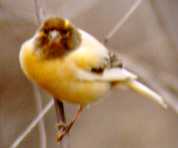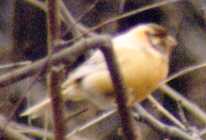





The bird's plumage is very indicative of a type of canary where pigment production is not present in certain areas (this bird would be called a Veriegated yellow canary.) This color morph commonly has the eyebrow, dark hood (sometimes lacking pigment on the nape, throat, crown, and/or cheeks), white or very light primaries, and dark secondaries. (note these characteristics on the photographed bird.) The birds song was that of a male canary, consisting of about three pur-whee's (accent, and raise the pitch on the whee), then about three of the same whee's, then a long series of bubbly notes rising and falling in pitch. I spoke with an older gentleman who breeds canaries, and he informed me that they may become aclimated to colder environments by slowley exposing them to colder and colder temperatures over long periods of time. More abrupt temperature changes result in respiratory infections and usually death.
Return to the main page...